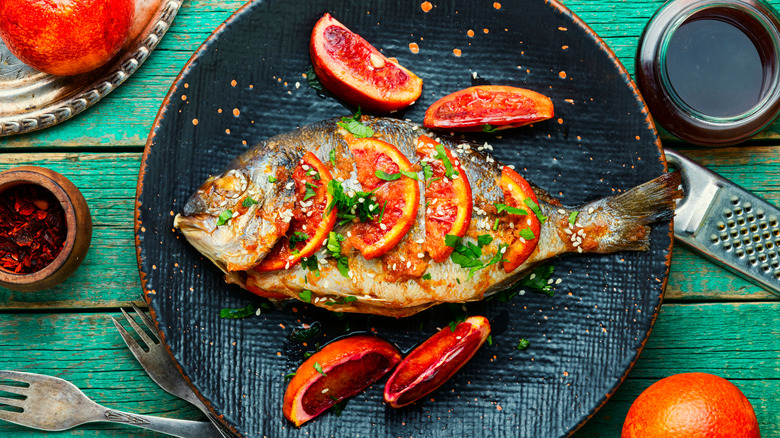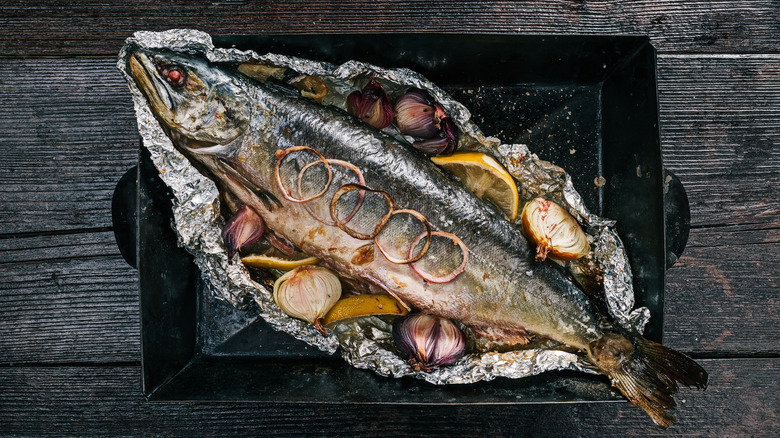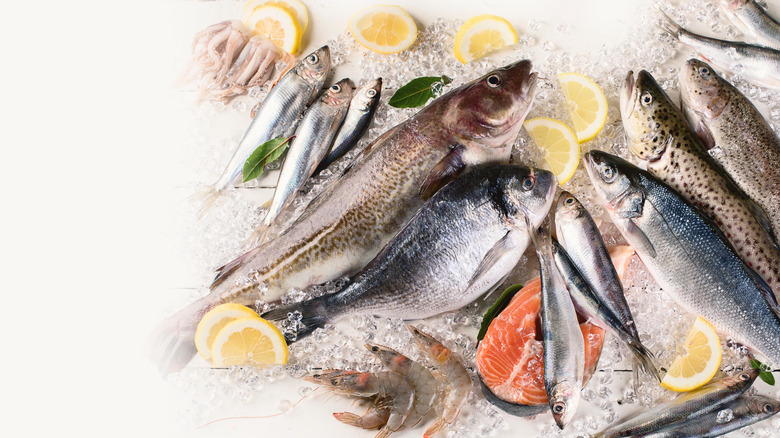You Should Roast Your Fish Whole. Here's Why
Fish is one of those rare gems that has it all, arriving at that perfect intersection of actually-good-for-you and actually-tastes-delicious. Filled with high-quality protein and omega-3 fatty acids (via Healthline), it's got oodles of nutrition and health benefits while being one of the tastiest, most versatile things you can eat.
For us fish lovers out there, we know there's no wrong way to prepare it as long as it's executed well. You may like your fish skin-on and pan-seared for extra crispiness, filleted and slowly baked in parchment paper until it becomes fall-off-your-fork buttery, or lightly fried and stuffed inside a fresh taco.
But there's one way to cook fish that might trump all others: roasting it whole. Yes, that means skin and bones and googly eyes and all. But don't be intimidated or grossed out — when you grab that whole fish by the gills and cook it to perfection, you'll wonder why you haven't been cooking it this way the whole time.
Reasons to roast your fish whole
There's something you get when choosing a whole fish that you don't get with other seafood cuts and preparations: the bones. Similar to other meat, the bones bring big flavor. Domenica Marchetti, recipe developer and food writer, tells The Washington Post that once she tried whole-roasting her fish, she noticed the meat came out sweeter and tastier. "This makes sense," she says. "Fish bones impart flavor, while the skin keeps the flesh beneath moist as it roasts." Aside from the ultimate flavor and tenderness that holds out even if you happen to overcook it, you get the bonus of one of the best parts of a fish: that crispy skin, and there's more of it to go around!
Another great reason to roast a fish whole? It's usually easier to tell how fresh a whole fish is when you buy it (more on that below), so you can guarantee quality and freshness to bring your meal to its full potential. It's a surprisingly simple way to cook fish, even though the final product may look complicated. All the cleaning, scaling, and gutting will be done for you when you buy it, and from there, all it takes is a little seasoning and a drizzle of olive oil.
It'll taste better, fresher, and more flavorful than the fish you've been making, it requires less preparation, and it's a great way to serve fish for a crowd.
Tips for choosing and cooking your fish
When choosing a fresh fish, Martha Stewart recommends that you look at a few qualities to ensure ultimate freshness: eyes that are bulbous and clear (rather than sunken or foggy), gills that are bright or red-colored (rather than a dull gray or brown), flesh that's firm to the touch, and a clean smell that's not too fishy. If you consider these factors, you can choose the freshest fish available rather than opt for a potentially questionable (and probably previously frozen) fillet.
Certain types of fish are ideal for buying and roasting whole. Many white fish, like sea bass and branzino, will cook easily and come out nicely. Martha Stewart also recommends red snapper, bass, and trout — all easily found at your local fish market or grocery store seafood department.
Some other tips: make sure you pat your fish dry before you roast it, and be generous when you rub it down with olive oil and add your seasonings. You'll know the fish is ready when the flesh is opaque and easily flakes away from your fork, or try a simple skewer test to check for doneness.


